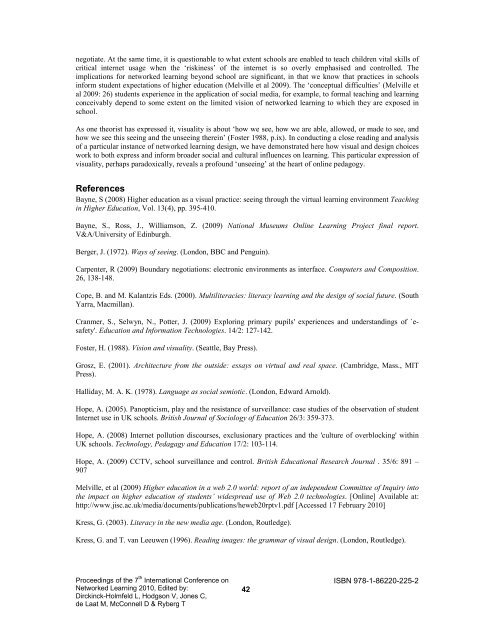Full Paper - .pdf
Full Paper - .pdf
Full Paper - .pdf
Create successful ePaper yourself
Turn your PDF publications into a flip-book with our unique Google optimized e-Paper software.
negotiate. At the same time, it is questionable to what extent schools are enabled to teach children vital skills of<br />
critical internet usage when the ‘riskiness’ of the internet is so overly emphasised and controlled. The<br />
implications for networked learning beyond school are significant, in that we know that practices in schools<br />
inform student expectations of higher education (Melville et al 2009). The ‘conceptual difficulties’ (Melville et<br />
al 2009: 26) students experience in the application of social media, for example, to formal teaching and learning<br />
conceivably depend to some extent on the limited vision of networked learning to which they are exposed in<br />
school.<br />
As one theorist has expressed it, visuality is about ‘how we see, how we are able, allowed, or made to see, and<br />
how we see this seeing and the unseeing therein’ (Foster 1988, p.ix). In conducting a close reading and analysis<br />
of a particular instance of networked learning design, we have demonstrated here how visual and design choices<br />
work to both express and inform broader social and cultural influences on learning. This particular expression of<br />
visuality, perhaps paradoxically, reveals a profound ‘unseeing’ at the heart of online pedagogy.<br />
References<br />
Bayne, S (2008) Higher education as a visual practice: seeing through the virtual learning environment Teaching<br />
in Higher Education, Vol. 13(4), pp. 395-410.<br />
Bayne, S., Ross, J., Williamson, Z. (2009) National Museums Online Learning Project final report.<br />
V&A/University of Edinburgh.<br />
Berger, J. (1972). Ways of seeing. (London, BBC and Penguin).<br />
Carpenter, R (2009) Boundary negotiations: electronic environments as interface. Computers and Composition.<br />
26, 138-148.<br />
Cope, B. and M. Kalantzis Eds. (2000). Multiliteracies: literacy learning and the design of social future. (South<br />
Yarra, Macmillan).<br />
Cranmer, S., Selwyn, N., Potter, J. (2009) Exploring primary pupils' experiences and understandings of `esafety'.<br />
Education and Information Technologies. 14/2: 127-142.<br />
Foster, H. (1988). Vision and visuality. (Seattle, Bay Press).<br />
Grosz, E. (2001). Architecture from the outside: essays on virtual and real space. (Cambridge, Mass., MIT<br />
Press).<br />
Halliday, M. A. K. (1978). Language as social semiotic. (London, Edward Arnold).<br />
Hope, A. (2005). Panopticism, play and the resistance of surveillance: case studies of the observation of student<br />
Internet use in UK schools. British Journal of Sociology of Education 26/3: 359-373.<br />
Hope, A. (2008) Internet pollution discourses, exclusionary practices and the 'culture of overblocking' within<br />
UK schools. Technology, Pedagagy and Education 17/2: 103-114.<br />
Hope, A. (2009) CCTV, school surveillance and control. British Educational Research Journal . 35/6: 891 –<br />
907<br />
Melville, et al (2009) Higher education in a web 2.0 world: report of an independent Committee of Inquiry into<br />
the impact on higher education of students’ widespread use of Web 2.0 technologies. [Online] Available at:<br />
http://www.jisc.ac.uk/media/documents/publications/heweb20rptv1.<strong>pdf</strong> [Accessed 17 February 2010]<br />
Kress, G. (2003). Literacy in the new media age. (London, Routledge).<br />
Kress, G. and T. van Leeuwen (1996). Reading images: the grammar of visual design. (London, Routledge).<br />
Proceedings of the 7 th International Conference on<br />
Networked Learning 2010, Edited by:<br />
Dirckinck-Holmfeld L, Hodgson V, Jones C,<br />
de Laat M, McConnell D & Ryberg T<br />
42<br />
ISBN 978-1-86220-225-2

















